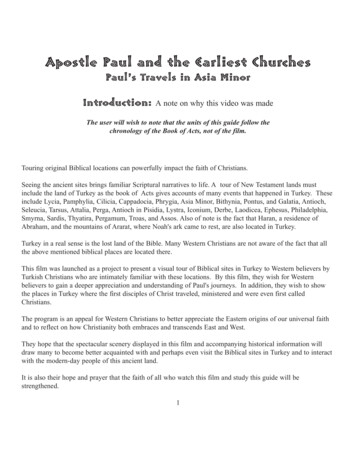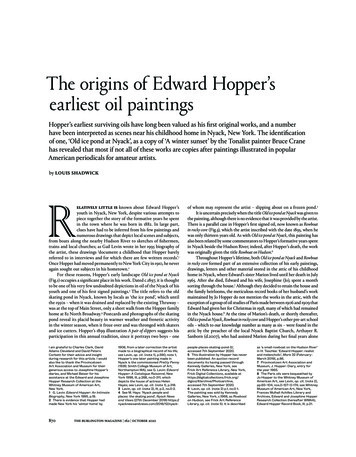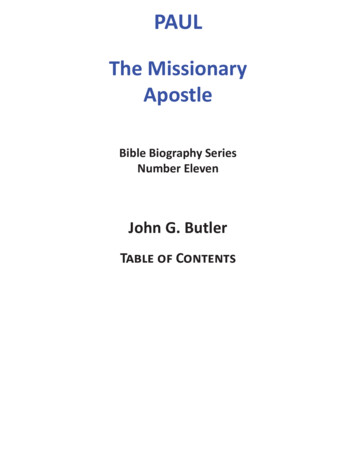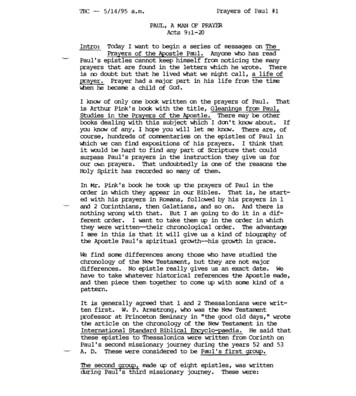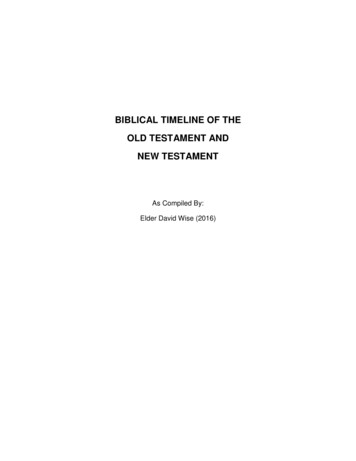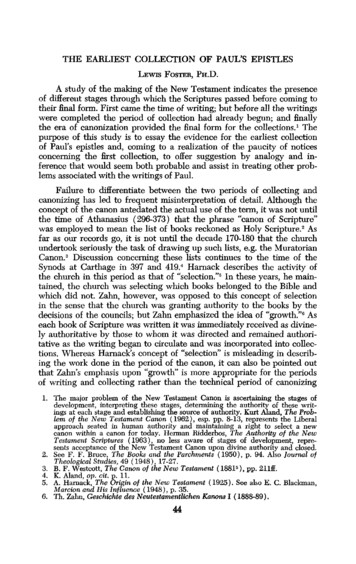
Transcription
THE EARLIEST COLLECTION OF PAUL'S EPISTLESLEWIS FOSTER, P H . D .A study of the making of the New Testament indicates the presenceof different stages through which the Scriptures passed before coming totheir final form. First came the time of writing; but before all the writingswere completed the period of collection had already begun; and finallythe era of canonization provided the final form for the collections.1 Thepurpose of this study is to essay the evidence for the earliest collectionof Paul's epistles and, coming to a realization of the paucity of noticesconcerning the first collection, to offer suggestion by analogy and inference that would seem both probable and assist in treating other problems associated with the writings of Paul.Failure to differentiate between the two periods of collecting andcanonizing has led to frequent misinterpretation of detail. Although theconcept of the canon antedated the actual use of the term, it was not untilthe time of Athanasius (296-373) that the phrase "canon of Scripture"was employed to mean the list of books reckoned as Holy Scripture. 2 Asfar as our records go, it is not until the decade 170-180 that the churchundertook seriously the task of drawing up such lists, e.g. the MuratorianCanon.3 Discussion concerning these lists continues to the time of theSynods at Carthage in 397 and 419.4 Harnack describes the activity ofthe church in this period as that of "selection."5 In these years, he maintained, the church was selecting which books belonged to the Bible andwhich did not. Zahn, however, was opposed to this concept of selectionin the sense that the church was granting authority to the books by thedecisions of the councils; but Zahn emphasized the idea of "growth."6 Aseach book of Scripture was written it was immediately received as divinely authoritative by those to whom it was directed and remained authoritative as the writing began to circulate and was incorporated into collections. Whereas Harnack's concept of "selection" is misleading in describing the work done in the period of the canon, it can also be pointed outthat Zahn's emphasis upon "growth" is more appropriate for the periodsof writing and collecting rather than the technical period of canonizing1. The major problem of the New Testament Canon is ascertaining the stages ofdevelopment, interpreting these stages, determining the authority of these writings at each stage and establishing the source of authority. Kurt Aland, The Problem of the New Testament Canon (1962) , esp. pp. 8-13, represents the Liberalapproach seated in human authority and maintaining a right to select a newcanon within a canon for today. Herman Ridderbos, The Authority of the NewTestament Scriptures (1963), no less aware of stages of development, represents acceptance of the New Testament Canon upon divine authority and closed.2. See F. F. Bruce, The Books and the Parchments (1950), p. 94. Also Journal ofTheological Studies, 49 ( 1 9 4 8 ), 17-27.3. B. F. Westcott, The Canon of the New Testament ( 1881 5 ), p p . 21 Iff.4. K. Aland, op. cit. p. 11.5. A. Harnack, The Origin of the New Testament (1925). See also E. C. Blackman,Marcion and His Influence ( 1948), p. 35.6. Th. Zahn, Geschichte des NeutestamentlichenKanons I ( 1888-89).44
FOSTER: THE CANON OF THE BIBLE45in the years 180-397 when this growth would have already been complete.A better word to characterize the period of the canon is "protection."This is the period when a wall was built around the village that hadalready been there for years; but now, both to protect the original, inspired inhabitants and to keep out uninspired newcomers, the protectionof the canonical wall is erected to assure safety and preservation. Authority was not gained by including a book in the sacred list but it appearedin the list of Scripture because its authority had already been acknowledged throughout the earlier periods of writing and collecting.7The period of collection is not so clearly marked off as that of thecanon. Different parts of the New Testament belonged to differentcollections, some made earlier than others. The Diatessaron is one example of the Gospel collection that must have been brought togetheryears earlier than the Diatessaron's publication c. 150; for Tatian usedfor his consecutive narrative these four canonical Gospels, no more andno less. Also the epistles of Paul must have been collected as soon orsooner than the Gospels as witnessed by early references and usage.Earlier than the work of Tatian is the collection of books used as Scripture by Marcion.8 This included Luke and ten epistles of Paul, knownas the Gospel and Apostle. Similar designation had already been used byIgnatius. 9 Another striking reference comes from the conglomerateJewish-Christian writing, The Testaments of the XII Patriarchs (Benj.I I ) 1 0 where it is told under cover of an ex post facto prophecy that the"work and word" of Paul ( Warfield notes this is confessedly the book ofActs and Paul's Epistles), 11 "shall be written in the Holy Books" i.e., asis generally accepted, made a part of the existent Bible.12 Another interesting reference is found in the Acts of the Scillitan Martyrs (c. 180)where the contents of the satchel of the martyr Speratus are describedas "books and epistles of Paul a just man."13 The "books" may or may notrefer to the Gospels and Acts but the second designation is explicitly theepistles of Paul. Just as the old Scriptures were the 'law and the prophets"7. See F. F. Bruce, op. cit., pp. 94, 95. See also B. B. Warfield, The Inspiration andAuthority of the Bible (reprint 1948), pp. 411-16. Warfield's emphasis in hisstudy of the canon could be characterized by the word, "extension," for hefocuses on the new Scripture as a continuance or extension of the old.8. G. Bardy, "Marcion," Dictionnaire de L· Bible, Supplement, 5, fase. 27 (1954)862-77; A. Harnack, Marcion ( 1921 ) ; J. Knox, Marcion and the New Testament(1942).Contemporary also to Marcion's time is the Gnostic Gospel of Truth which vanUnnik maintains gives evidence of a New Testament canon similar to our ownalready in existence. See The Jung Codex, F. L. Cross, ed. (1955), pp. 81-129.9. Ad Phihd. 5. See B. B. Warfield, op. cit., pp. 413, 414.10. "Until the consummation of the age shall he be in the synagogues of theGentiles, and among their rulers, as a strain of music in the mouth of all. Andhe shall be inscribed in the holy books, both his work and his word, and heshall be a chosen one of God for ever."11. Warfield, loc. cit.12. See also II Clement 14 ( "the books and the Apostles" ).13. See Blackman, op. cit., p. 30.
46BULLETIN OF THE EVANGELICAL THEOLOGICAL SOCIETYso the new were the Gospel and the apostles,14 but it is impossible to sayhow early these collections were made. 15As far back as our extracanonical, datable Christian literature goes,Christians were using the epistles of Paul. It is noteworthy that whenClement of Rome wrote to the Corinthians, he did not neglect to mentionPaul's epistle to them (I Clement 47.1), when Ignatius wrote to theEphesians, he referred to the epistles of Paul (Ephesians 12:2), andwhen Polycarp wrote to the Phüippians he too draws attention to theepistles of Paul (Philip. 11.3). In fact every time an Apostolic Fatherwrote to a place which had received an epistle of Paul, they made reference to the apostle and his letters.16 In the writings of Polycarp, onefinds evidence of all of the epistles of Paul except I Thessalonians, Titusand Philemon.17 The use of Paul's epistles in the Apostolic Fathers leadsone to a conviction that the collection of his epistles must have been madeprior to their period. 18 But this brings one into the very period of thewriting of the New Testament books for the collecting of Paul's epistles.The question remains, how early in the first century was the collectionmade?In II Peter 3:15, 16 direct reference is made to "all of Paul's epistles."And account that the longsuffering of our Lord is salvation; evenas our beloved brother Paul also according to the wisdom givenunto him hath written unto you; as also in all his epistles, speaking in them of these things; in which are some things hard tobe understood, which they that are unlearned and unstablewrest, as they do also the other scriptures, unto their owndestruction.Since this passage not only indicates that Paul's epistles have been collected but that they are also considered as Scripture, this notice is particularly troublesome to those who would insist that these books mustwait for the period of the canon for the church to select them. But inorder to surmount this testimony the Liberal must deny the authorshipof Peter to this second epistle and relegate it to the second century to fit14. Clement of Alexandria, Strom. 6.11.88; Tertullian, De Proes. Haer. 36. See . B.Warfield, op. cit., pp. 413, 14.15. Streeter traces four stages of the Roman Corpus Paulinum beginning with IClement, A.D. 96, The Four Gospels ( 1951 ), p. 526f. A gradual process over aperiod of years is advocated by Harrison, Polycarp's Two Epistles to the Philippians (1936), pp. 236ff. K. Lake, The Earlier Epistles of Paul (1927), pp. 256ff.16. Furthermore they speak of Paul in a more revered way than his contemporaryand equal, Peter speaks of him ("our beloved brother"): "the blessed andglorious Paul (Polycarp, ad Philad. 3); "the blessed Paul" (I Clement, 47.1;Polycarp, ad Philad. 11); "the sanctified Paul.right blessed" (Ignatius, adEph. 12.2).17. A. Wikenhauser, New Testament Introduction ( 1963), p. 30.18. See The New Testament in the Apostolic Fathers ( 1906).
FOSTER: THE CANON OF THE BIBLE47preconceived notions of naturalistic development in the church and itswritings.19One might enquire, however, what if this epistle is taken to be justwhat it purports to be, an epistle by Peter,20 and just as the church hasjudged it to be from the beginning through nineteen centuries,21 and seewhat this would suggest of the earliest collection of PauTo epistles?22At the outset this testimony of the collection of Paul's epistles beforethe end of Peter's life (c.68) would rule out the frequently expressed notion that the first collection was made in the nineties. This is a commondate given both by Goodspeed and his followers in America23 and byother on the continent24 although they do not follow Goodspeed's theoryof what happened. According to GoodspeecTs hypothesis a man ofColossae supposedly read the newly published book of Acts and havingvisited the places named in Acts found that Paul had written to someof them and having collected these epistles, he wrote a cover epistle as ifby Paul and it came to be known as Ephesians.25 Even if there were nonotice in II Peter to the contrary, it would be incredible to maintain that19. E.g., A. E. Barnett insists (The Second Epistle of Peter, Interpreter's Bible[1957], p. 164) that such a reference to Paul's letters (II Peter 3:15, 16) is"an anachronism which forms an indubitable water-mark of the second century." On the other hand, E. M. B. Green maintains: " . . .the only real difficultylies in one apostle's regarding the letters of another as Scripture. In view, however, of the apostolic assertion that the same Holy Spirit who inspired the OldTestament writings was active in their own (I Cor. 2:13), and the claims ofPaul to have the mind of Christ (I Cor. 2:16) and to lay down rules for allthe churches (I Cor. 7:17) which are equated with the commandment of Christ(I Cor. 14:37) and rejection of which will bring rejection by God (I Cor. 14:38RSV), this possibility cannot be excluded." J. D. Douglas, ed. The New BibleDictionary (1962), p. 979.20. "There can be no doubt that the author intends his readers to understand thathe is the apostle Peter." D. Guthrie, New Testament Introduction, Hebrews toRevelation (1962), p. 143.21. "Although the external evidence is not so strong and early as for other NewTestament books, Guthrie can still say: "It would seem a fair conclusion to thissurvey of external evidence to submit that there is no evidence from any partof the early Church that this Epistle was ever rejected as spurious, in spite ofthe hesitancy which existed over its reception." Op. cit., p. 142.22. In support of the Petrine authorship of II Peter, see also T. Zahn, Introductionto the New Testament, II (1909), pp. 194ff.; C. Bigg, St. Peter and St. Jude(1902); E. I. Robson, Studies in II Peter (1915); E. M. B. Green, II Peter Reconsidered (1961).23. See the theory and variations: E. S. Goodspeed, "The Place of Ephesians inthe First Pauline Collection," Anglican Theological Review, 12 (1930), 189-212.New Chapters in New Testament Study (1937), chapters 1-3. An Introductionto the New Testament (1937) pp. 210-39. The Meaning of Ephesians (1933),pp. 82if. The Key to Ephesians (1956), pp. vff. C. L. Mitten, The Formation ofthe Pauline Corpus of Letters ( 1955). A. E. Barnett, Paul Becomes a Literary Influence ( 1941 ). J. Knox, Philemon Among the Letters of Paul ( 1935 ).24. Feine, Behm, Kummel, Introduction to the New Testament (1966 14 ), p. 338.Also K. L. Caroli, "The Expansion of the Pauline Corpus," Journal of BiblicalLiterature, 72 (1953), 230-37.25. Goodspeed waxes so bold as to suggest that Onesimus is the author of Ephesiansand the first collector of Paul's epistles. Introduction to the New Testament(1937), p. 239.
48BULLETIN OF THE EVANGELICAL THEOLOGICAL SOCIETYChristians would wait over thirty years before attempting to gather thewritings of Paul. 26 To answer this objection Goodspeed proposes thatPaul fell into disfavor in these thirty years and only at the gain of popularity was the collection made. GoodspeecTs only attempt to justify thisbelief is to maintain a lack of use of Paul's epistles in the Christianliterature of the period.27 What Goodspeed fails to make clear is thatthere is no datable Christian literature from this period except the NewTestament, and if the epistles of Paul are alluded to there, as they arein II Peter, then Goodspeed insists that work must be relegated to a latertime than 90. Certainly the absence of reference to Paul's epistles in thebook of Acts, whatever the explanation may be, cannot be attributed toa feeling of disfavor toward Paul in a book so dedicated to the work ofthis apostle.That the Apostolic Fathers use the New Testament writers in a different way from the usual quotation of the Old Scriptures does not meanthe authors of New Testament writings were in disfavor nor lower inauthority. Those living so close to the apostolic age, e.g., as Irenaeussaid of Clement "with the preaching of the apostles still ringing in hisears,"28 did not wish to relinquish their contemporaneity with apostolicbeginnings by quoting as ancient authority those who were contemporaryor almost contemporary authority. 29The most common attempts to reconstruct the earliest collectionsof Paul, some striving to remain within the bounds of the II Peter reference to Paul's epistles and some ignoring these limits, have emphasizedthe role of the local churches in the work of collection.30 Perhaps at26. Harnack points out that references within the epistles themselves establish thecontemporary recognition of Paul's writings: II Corinthians 10:10, Paul's opponents acknowledge his letters are 'weighty and powerful/ II Corinthians 3:1, 10:9admits his skill in letter-writing, I Corinthians 7:17 involves communication with'all the churches/ II Thessalonians 2:2; 3:17 evidently indicate false letterswhich would point up the high repute of Paul's genuine letters. Die Briefsammlung ( 1926 ), pp. 7, 8. Paul gave instruction that his epistle be read "to all thebrethren" (I Thessalonians 5:27), and instruction for the exchange of epistles(Colossians 4:16).27. "Before the publication of Luke-Acts nobody knew them (epistles of Paul); afterthe appearance of Luke-Acts (about A.D. 90) everybody knows them/' Goodspeed, Introduction to the New Testament (1937), p. 211, Mitton adds the supposed argument that dislocations and interpolations in the extant Pauline Epistlesshow an early period of neglect for Pauline writings. His examples of allegedinterpolations and disorder, however, are not established and his very principleof textual variation spelling neglect is inconclusive. Mitton, op. cit. pp. 25fF,cf. D. Guthrie, New Testament Introduction, The Pauline Epistles (1961), p.261.28. Irenaeus, adv. Haer. 3.3.3.29. Furthermore an absence of quotations cannot be interpreted that these writingswere not in existence, were not known, or were not collected. Guthrie warnsagainst those theories which assume that non-quotation must indicate noncirculation. "If Clement, for example, cites few of Paul's Epistles it is precariousto assert he must have been ignorant of the rest."30. See D. Guthrie, op. cit., pp. 257ff.
FOSTER: THE CANON OF THE BIBLE49Ephesus, 31 perhaps at Corinth, 32 the earliest full collection was made. 33It is possible, however, that the earliest collection is to be traced, notto the activity of the churches which received the epistles, but to thedispatching end of the epistles. Guthrie suggests that Timothy may havebeen responsible for putting together these inspired writings soon afterPaul's death because he had access to the copies of these epistles thatwould have been kept by Paul.34 But if this were the case, the referencein Peter would indicate a still earlier collection, for during the lifetimeof Peter, and one would also then assume, during the lifetime of Paul,a collection had already been made.Another name which suggests itself as a likely candidate for theearliest collector of Paul's epistles is Luke. Here was a personal companion of Paul, a skilled writer, and one anxious to present the "work andword" of Paul to the churches.In antiquity to retain copies of letters dispatched to far places wascustomary. Because of the uncertainty of the postal system and becauseof the desirability to have a dependable record of what was originallywritten in case question should later be raised about the correspondence—both of these reasons fully justified the common practice of makingcopies of correspondence. 35 When Ignatius was passing through AsiaMinor on his way to death in Rome, he wrote seven epistles. The Christians at Philippi wanted a collection of these letters and sent to Polycarp,requesting them. Polycarp complied with their request and sent a coverepistle under his own name to accompany them. In this transactionenough time had not elapsed for the particulars of Ignatius' death tohave arrived.36 It is highly unlikely that it was necessary to travel toeach church to secure copies of their letters. In fact the amanuensis,Burrhus, who had accompanied Ignatius was from Ephesus 37 and wasthe logical one to provide copies of that which had been written alongthe way.The role of the amanuensis in both supplying copies and sharing incollections is in evidence in the case of another famous letter writer,31. B. H. Streeter, The Primitive Church (1929), p. 160, E. Goodspeed, New Solutions of New Testament Problems ( 1927 ), pp. Iff.32. A. Harnack, Die Briefsammlung des Apostels Paulus (1926), 1, 4, 88ff and 73,n. 11, 12. Wikenhauser, op. cit., p. 31.33. SchmithaFs supposition that the earliest collection was at Corinth around 80and included only seven of his epistles has only an arbitrary exclusion of Colossians, Ephesians, and Philemon ("Zur Abfassung und ältesten Sammlung derpauhnischen Hauptbriefe," Zeitschrift fur die neutestamentlichen Wissenschaft,51 [1960], 225ÍF.34. D. Guthrie, op. cit., pp. 267-9.35. R. L. Archer maintains that Paul kept copies or partial copies of all his letters."The Epistolary Form in the New Testament," Expository Times, 63 (1951-52),296ff.36. J. B. Lightfoot, The Apostolic Fathers. Part II, Sec. II ( 1885), p. 933.37. J. B. Lightfoot, The Apostolic Fathers. Part II, Sec. II (1889), p. 34. See Ignatius, Philad. 11.2: "I am writing thence to you by the hand of Burrhus, who wassent with me by the Ephesians and Smyrnaeans as a mark of honour." AlsoSmyrn. 12:1.
50BULLETIN OF π EVANGELICAL THEOLOGICAL SOCIETYCicero. The earliest collection of his epistles was made by Tiro, his38chief secretary, either before Cicero's death or soon after. Althoughit is not likely that such figures as Cicero or Seneca would have beenthe example to provide direct impetus leading to the collecting of Paul'sletters, 39 nevertheless the known Roman practice of the role of theamanuensis in preserving copies and sharing in the task of collectionsmay throw light upon the way the corpus of Paul's writings was firstbegun.Paul had more than one amanuensis who might have aided in acollection, but there are additional considerations which point towardLuke. A relationship has long been noted between the book of Acts andthe Pauline epistles. One looks to Acts in order to gain an understandingof the way the writing of these epistles fits into the Ufe of Paul. But whyconsider this an accident? Why should this not be considered a deliberatemotive in the selection of material covered by Luke in Acts?Paul writes to the Romans that he has preached the gospel of Christunto Illyricum; but one reads nothing in Acts about Illyricum. On secondthought, Paul did not write an epistle to Illyricum; but Luke tellsespecially of those places where Paul did write: Galatia, Philippi, Thessalonica, Corinth, Ephesus, and Rome. This leaves only the Colossianepistle unaccounted for among the Pauline church epistles. Luke doesnot tell of Paul's association with Colossae; but it is highly doubtful thatPaul worked personally in Colossae. Among the noteworthy purposes inwriting Acts, perhaps the place of a cover work to introduce the epistlesof Paul should be included.Another possible motive in writing Acts has been associated withthe pending trial of Paul in Rome. 4 0 What better preparation for a casethan to be able to present to the magistrate a document such as Actstelling of the activity of Paul in his work as an apostle of the Lord. Butto this might be added further valuable testimony, a collection of the verywritings of Paul to these churches that are described in Acts. Then thewritings available for the information of the court would include boththe work and words of Paul, the Acts and his epistles.Is there any indication that the book of Acts expected such a continuation? For years scholars have struggled with the question of apossible third volume to accompany the two volumes Luke-Acts. 41 The38. For a treatment of epistolography, see A. Deissmann, Bible Studies (1901), 3-59;esp. on Cicero, p. 30. See also for bibliography, The Oxford Classical Dictionary(1949), pp. 497f, 190f; A. Wikenhauser, op. cit. pp. 346-51; Feine, Behm, Kummel, op. cit., pp. 176ff.39. So R. L. Archer maintains that Seneca with his insistence that a worthy collection of letters should set forth a philosophy was the impetus for thefirstcollectionof Paul's epistles. Op. cit. pp. 296ff.40. H. J. Cadbury, "Roman Law and the Trial of Paul" in The Beginnings ofChristianity, vol. 5, esp. p. 298; D. Guthrie, op. cit., pp. 319f. Strongest resistance to this possibility has been raised by those advocating a late date forActs (See Feine-Behm-Kummel, op. cit., p. 114).41. See The Beginnings of Christianity, vol. IV, p. 349. Also D. Guthrie, op. cit. p.309.
FOSTER: THE CANON OF THE BIBLE51opening Acts uses the word "proton9 in referring to the Gospel narrative(Acts 1:1). This is invariably translated "former," but by strict classicalgrammar it should be rendered "first" (proteron would be "former"). 42 IfLuke referred to his Gospel account as the first volume instead of former,it would expect a third volume since he would be comparing the workwith more than one other.43 If the wording expects a third volume, whathas happened to it? Numerous suggestions have been made: the authordied, the work was suppressed, the work was lost or abandoned, orthe intention was never begun in reality. Few have been satisfied withany of these answers. The position, however, that Luke collected theepistles of Paul and published them provides a solution for Luke's thirdvolume. Luke both expected to publish a third volume, and he did, and itis extant today. The earliest collection of Paul's epistles may well be thethird volume of Luke's work.Another question that has puzzled many who study the contents ofActs is that nowhere in its pages does one find any mention of Paul'sepistles. How could Luke omit at least a mention of the writing of thesevital documents? 44 This too can be explained by Luke's awareness thathe was going to publish Paul's epistles as a third volume. In the secondvolume, Acts, the absence of reference to the earthly life of Jesus isnotable. Luke neither repeats nor adds to the material he has given inthe first volume concerning the life of Christ except in the opening chapter where he links the close of the first volume to the opening of thesecond and in the recording of speeches. This was careful separation ofmaterial to the respective volumes. In the same way the epistles of Paulare not mentioned in the second because they are to occupy the third.If Luke made the earliest publication of Paul's epistles, what wasthe extent of this collection? This would depend somewhat upon thetime of publication. The abrupt ending of the book of Acts is best explained by the dating of its writing at the time of the last event recordedin Acts.45 But if the third volume had already been assembled for use inthe near future, this then would allow three or four years from Luke'spossible collection to the time of Peter's statement (II Peter 3:15, 16)which alludes to "all of Paul's epistles." But if the collection were madethis early, the Pastoral Epistles would not yet have been written. Only ten42. W. M. Ramsay, St. Paul the Traveler and the Roman Citizen (1898), pp. 27ff.Although the distinction between proton and proteron was weakening in theHellenistic period, Luke was exacting in his use of the Greek.43. The absence of any reference to Theophilus at the close of Acts is an additionalnote which might expect a third volume. It was customary to close the finalvolume with a mention of the person addressed as well as opening each individual volume with a reference to him. This was not a hard and fast rule, however. See The Beginnings of Christianity, vol. IV, p. 349.44. See Guthrie, op. cit. pp. 260f n. 5. Whether ignorance, deliberate neglect or aninterest in adventure, not theology, is offered as an explanation of the silence,none has satisfied the critics.45. So Harnack finally concluded: The Date of Acts (1911), pp. 90-125. Also F. F.Bruce, Commentary on the Book of the Acts (1955), pp. 22ff; F. M. Blaiklock,The Acts of the Apostles ( 1959) support the early dating of Acts.
52BULLETIN OF THE EVANGELICAL THEOLOGICAL SOCIETYepistles of Paul had been issued by the time of his release from his first46Roman imprisonment. One might ask why Luke-Acts-and ten epistles ofPaul are not found circulating together if this is an early three volumework. In defense it might be noted that nowhere does one find Luke andActs coupled together either alone or in collections. Yet there wouldhave been an early time prior to their arrangement in other collectionswhen they must have been together. It is noteworthy, however, that onedoes find Luke associated with the ten epistles of Paul in the GospelApostalicon of Marcion. 47 This is not a case of Marcion's making the firstcollection of Paul's epistles, nor his cutting out the Pastorals from a fullCorpus, 4 8 but perhaps his utilizing the earliest collection of Luke whichlacked the Pastorals. 49 Marcion's omission of Acts from the trilogy isunderstandable, arising from his aversion to anything Jewish and becauseof Acts' division of material between Paul and Peter, between apostlesto the Gentile and to the Jew.The suggestion that Luke is the earliest collector of Paul's epistlesand published them as a third volume has implications in many questionsrelating to special introduction as well as text and canon. For example, ifLuke wrote Acts to provide a background for the destination of theepistles, the Galatian epistle is undoubtedly addressed to the churches ofthe Roman province which are described in Acts, the so-called SouthGalatian theory. As an example of textual implications, the assured conclusion that Marcion used the Western Text 5 0 introduces the possiblerelationship of the Western Text with the earliest editions of Luke's46. On Paul's release, see D. Guthrie op. cit. p. 210-13.47. The order of Marcion's arrangement for the ten epistles is not that common tolater collections. The most frequently used explanation is the anti-Jewishprejudice that prompted his putting Galatians first. On the order, see T. Zahn,Geschichte des Neutestamentlichen Kanons, II, (1890-92), pp. 344ff. . Lake,Earlier Epistles of St. Paul (1911), p. 356. I Corinthians heads the lists in theMuratorian Canon and in Tertullian. Mitton maintains that the original collection would probably have been issued in two rolls and that Ephesians and thetwo Corinthians epistles could have filled the first roll. C. H. Buck, "The EarlyOrder of the Pauline Corpus," Journal of Biblical Literature 68 (1949), pp.351-357, objects to the Goodspeed—Knox hypothesis for the order of the Epistlesusing Ephesians first as cover epistle. No such listing is extant. Jack Fineganinsists that stichometry explains the order in each case and that the variantorders result from differing methods of counting stichoi. Harvard TheologicalReview 45 (1956) 85-103.48. There are those who give undue place to Marcion in the initial collection ofPaul's epistles. See F. C. Burkitt, The Gospel History and its Transmission1911), pp. 318f. Cf. . and S. Lake, An Introduction to the New Testament1938), p. 96. Guthrie, New Testament Introduction: The Pauline Epistles(1961), p. 255.49. Perhaps the supposed omis
Contemporary also to Marcion's time is the Gnostic Gospel of Truth which van Unnik maintains gives evidence of a New Testament canon similar to our own already in existence. See The Jung Codex, F. L. Cross, ed. (1955), pp. 81-129. 9. Ad Phihd. 5. See B. B. Warfield, op. cit., pp. 413, 414. 10.




